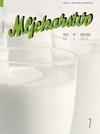Novel probiotic camel milk yoghurt supplemented with inulin: antibacterial, antioxidant and antidiabetic effects
IF 1.1
4区 农林科学
Q3 AGRICULTURE, DAIRY & ANIMAL SCIENCE
引用次数: 1
Abstract
Similar to cow’s milk, camel milk also contains the essential nutrients as well as potentially therapeutic compounds with antihypertensive, and antioxidant properties. In the current study, camel milk was used for developing a new probiotic camel milk yoghurt with commercial prebiotic (inulin). The camel yoghurt samples were evaluated by monitoring the changes in some physicochemical properties (pH, total acidity and synerisis) and bacterial viability and survival of Limosilactobacillus fermentum CABA16 during storage. Besides, antibacterial, ⍺-amylase and ⍺-glucosidase inhibitions and antioxidant activities and the sensory evaluation of this novel product were assessed. The pH values of samples decreased whereas total acidity values increased throughout 21 days of storage and Limosilactobacillus fermentum CABA16 maintained good viability with counts higher than 107 CFU g-1 at the end of storage. α-Glucosidase and α- Amylase Inhibitions Water-Soluble Extracts were higher than 35 and 55% respectively in probiotic (PY), prebiotic (InY) and symbiotic (SY) camel yoghurts at the end of storage period. Moreover, the highest antioxidant activities of the WSEs from camel yoghurts were around 49 and 61% by DPPH and ABTS assays respectively. The fortified probiotic camel yoghurts exhibited comparable antibacterial activities with maximum diameter of 12±0.07 mm on Staphylococcus aureus and Listeria monocytogenes strains. Lastly, the addition of probiotic and inulin significantly improved the sensory characteristics, except the colour, of camel yoghurts.添加菊粉的新型益生菌骆驼乳酸奶:具有抗菌、抗氧化和降糖作用
与牛奶类似,骆驼奶也含有必需的营养素以及具有抗高血压和抗氧化特性的潜在治疗化合物。在本研究中,骆驼奶被用于开发一种新的含有商业益生元(菊粉)的益生菌骆驼奶酸奶。通过监测发酵乳杆菌CABA16在储存过程中的一些物理化学性质(pH、总酸度和共溶性)、细菌活力和存活率的变化来评估骆驼酸奶样品。此外,还对该新产品的抗菌、淀粉酶和葡萄糖苷酶的抑制作用、抗氧化活性和感官评价进行了评价。在整个21天的储存过程中,样品的pH值降低,而总酸度增加,发酵乳杆菌CABA16在储存结束时保持了良好的活力,计数高于107CFU g-1。在储存期结束时,益生菌(PY)、益生元(InY)和共生(SY)骆驼酸奶中的α-葡萄糖苷酶和α-淀粉酶抑制水溶性提取物分别高于35%和55%。此外,通过DPPH和ABTS测定,骆驼酸奶中WSEs的最高抗氧化活性分别约为49%和61%。强化益生菌骆驼酸奶对金黄色葡萄球菌和单核细胞增多性李斯特菌菌株表现出相当的抗菌活性,最大直径为12±0.07 mm。最后,益生菌和菊粉的添加显著改善了骆驼酸奶的感官特性,但颜色除外。
本文章由计算机程序翻译,如有差异,请以英文原文为准。
求助全文
约1分钟内获得全文
求助全文
来源期刊

Mljekarstvo
Agricultural and Biological Sciences-Animal Science and Zoology
CiteScore
1.90
自引率
41.70%
发文量
18
审稿时长
12 weeks
期刊介绍:
Mljekarstvo is an open access, peer-reviewed international quarterly scientific journal. The first issue was published in 1951, by the Croatian Dairy Operators'' Association (today: Croatian Dairy Union, publisher). In a paper at a Union conference held 28 October 1951 in Zagreb it was said: "Our desire is that this magazine does not meet the fate of its predecessors, but that it continues to reflect the creative efforts and to provide guidelines for the producers as well as all other operators employed in the dairy industry."
It is our pleasure today to say that wishes of the enthusiasts who attended the conference have come true, and the magazine Mljekarstvo during the last six decades was a reflection of the creative efforts of numerous dairy scientists and experts, and through its texts it served as a guideline in improving production and processing of milk and dairy products. Mljekarstvo has been following all the achievements of the dairy profession in Croatia, and it also gives the short surveys of world achievements. The result of the research of local and foreign scientists and experts always find their place in the magazine Mljekarstvo. It has been edited by our outstanding dairy experts employed at colleges, research institutions and dairy companies.
 求助内容:
求助内容: 应助结果提醒方式:
应助结果提醒方式:


